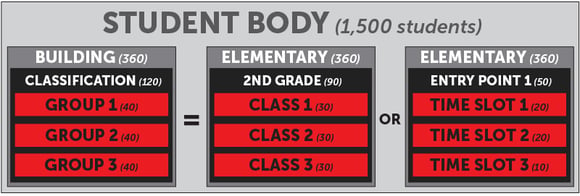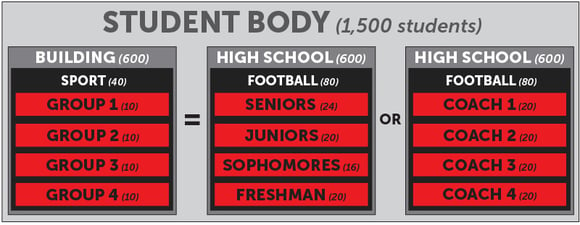You have choices when it comes to an athlete management system. You also have the right to be choose-y! Here's the lowdown on finding the right solution for your school.
We all understand there’s a huge time and cost savings when going electronic. But, what differentiates a basic online forms system versus one built for athletics? Companies who understand that every athletic department, school, and state have unique needs “get it”. After all, schools do business based on relationships. The best products are built based on customer feedback and supported by a team of “school people” that are driven by a mission to serve, not a mission to deliver ads or process credit cards.
Blog
Here is a list of key reasons why you need a form management system built for athletics:
Your 5 Point Checklist for the 2020 Virtual National AD Conference
This 5-minute read and a quick practice session is all you need to succeed at the AD Conference.
The NFHS NIAAA National Athletic Director’s Conference has been the premier event in the industry for 51 years. The excitement of visiting the host city, arriving in a big hotel room, learning new things, eating at new restaurants, seeing new gadgets and gear, and socializing with fellow ADs is an unparalleled opportunity that we all appreciate just a little bit more right now.
Soooo… yeah, 2020 will be a bit different.
The good news is you can still get a lot out of it. The AD Conference is more accessible than ever. Sessions, vendors, and new relationships await. It’ll just take a little more effort than your nice, big smile this year. Don’t worry, we’re here to help. We’ve come up with a simple checklist that includes all the skills and savvy you’ll make the most of the 2020 AD Conference.
Huddle up… here we go…
5 Savings Side Effects of FinalForms
Tight budget. Shrinking budget. No budget...
You have options.
We get it. COVID-19 sucks up funding, crushes budgets, disrupts time lines, and creates chaos in every athletic department. Your job as an AD is more demanding right now than it's ever been. As you look at your budget, it's time to cut unnecessary commitments and identify options that can save you time, money, and headaches.
(Stick around for the kicker at the end!)
Our VP of Sales Talks About AD's Perspectives on Technology
Responsible choices reflect the mission, vision, and values of any organization.
Dave Baker, our longest tenured Sales Team member, sees a change in AD's attitude toward technology.
"There is an expanding gap between companies that perform, and those that don't," claims Baker, "The best tech companies are delivering personable, reliable, and adaptable services. Decision making is getting easier... But only if you ask around. And I am thrilled that more and more ADs are looking to their peers to verify promises."
When Dave Baker left VNN to join FinalForms in 2014, he set a goal to create a positive impact on the culture of a business, his state, and an industry. Six years later, Baker looks back at explosive growth, key decisions, and the integrity behind FinalForms' impact.
7 Most Annoying Issues for Athletic Directors
If only you could go just one day without one of these issues, wouldn't life be grand?
Good news, we help ADs everywhere solve problems that plague the position. Our team, which includes 8 former ADs, helps pacify pain points with some advice learned from over 100 years in the field. Here is their advice:
(#6 is awesome!)
How to Create a K-12 School Social Media Policy
Social media is now ingrained in the fabric of our society. According to Pew Research, “95 percent of teens have access to a smartphone, and 45 percent say they are online ‘almost constantly.’ ” Further, the American Academy of Child & Adolescent Psychiatry states that 90 percent of teens between the ages of 13 and 17 have used social media, while 75 percent have at least one active profile. Social media use isn’t confined just to teens either; another report in the Journal of Educational Technology & Society found that 17 percent of kids use social media by the time they turn 9!
When Is It Time to Switch Online Student Registration Software?
Online student registration delivers a number of benefits to school districts of all sizes. Not only does the technology help you simplify the registration process, increase compliance, and unlock additional efficiency gains, but it also reduces your impact on the environment as you use considerably less paper and ink. Beyond that, online student registration platforms can help your district improve school safety and security while reducing errors and saving time.
The benefits of online student registration technology speak for themselves. But not every student registration platform is the same. Picking the wrong platform can expose you to a number of problems—such as frustrated employees, inaccurate data, and more. Let’s take a look at some indications that it might be time to upgrade your student registration management process.
Monitoring Health and Safety in Schools: 5-Step Guide
Health and safety play an essential role in ensuring a secure educational environment and a productive learning experience. When health and safety are lacking, it’s pretty much impossible to learn. That’s why all districts need to make health and safety a top priority.
Here's how 250 schools completed 605,379 COVID-19 health screenings
We get it. Reopening plans are tough. There are contingencies upon contingencies. You're faced with requirements, recommendations, and a polarized public.
We're here to help you set the basic foundation for a process every school will either nail or fail this Fall.
They nailed it!
What did 250 school districts do to implement successful health screening plans?
1. They Chose Where and When
Every school is unique. Defining where and when to conduct screenings helps determine the best plan.
- Daily Arrival: In-car? Entrances? Homeroom?
- Extracurricular Activities: In-car? Upon arrival?
- Sports: In-car? Alphabetical lineups? Small groups led by coaches?
- Events and Field Trips: Before boarding the bus? Gate/location entry?
2. They Chose the Best Tool
The most successful school leaders choose proven technologies to empower their staffers with mobile technologies to manage student health screenings.
- Is it mobile and secure?
- Is it easy-to-learn and easy-to-use?
- Can it automate notifications to parents or medical staffers?
- Can it meet state or local requirements?
- Can we generate reports?
3. They Established Standards
Providing standards for even the smallest tasks requires less on-the-spot 'thinking'. It may seem crazy, but standards allow your staffers to focus on the big picture rather than minutia.
- What questions will we ask?
- Who do we notify if a student is symptomatic?
- What are the return-to-learn or return-to-play requirements?
- Will a daily clearance be enough or will extracurriculars require a second screening?
- How will we break down our student population into small, manageable groups? Great question, here's how:
 FinalForms allows you to create groups from any set of students, and then conduct COVID-19 health screenings. In this example, we show how you may create classes within the 2nd grade at the elementary school. If you prefer to screen students prior to entry, you may create groups consisting of students who enter at a certain point at an assigned time.
FinalForms allows you to create groups from any set of students, and then conduct COVID-19 health screenings. In this example, we show how you may create classes within the 2nd grade at the elementary school. If you prefer to screen students prior to entry, you may create groups consisting of students who enter at a certain point at an assigned time.

In this graphic, we show you how you may break down a sport, football specifically, into smaller groups by class or by coach assignment.
4. They Educated Staffers, Parents, and Students
Community buy-in is key. The top performing schools had their staffers watch a 3-minute video or attend a webinar so they could efficiently screen students.
- How will we train the staff?
- Can we create an announcement so parents understand the process?
- Can we make it efficient enough so students don't get frustrated?
- Can we publish an article so the community understands both our procedures and our concern for public health?
FinalForms Expands COVID-19 Screening: Flexible, Custom K12 Options
We hear you! You need a flexible health screening tool that helps meet all of your K12 and Athletic needs. We got it!
FinalForms provides the flexibility meet your state, school, or health system specific COVID-19 health screening needs.
Whether you're reopening full-time, part-time, or in groups, we can help you meet compliance standards while increasing student and staff safety with a minimal investment of time and money.
We're here to help you prepare for anything!

